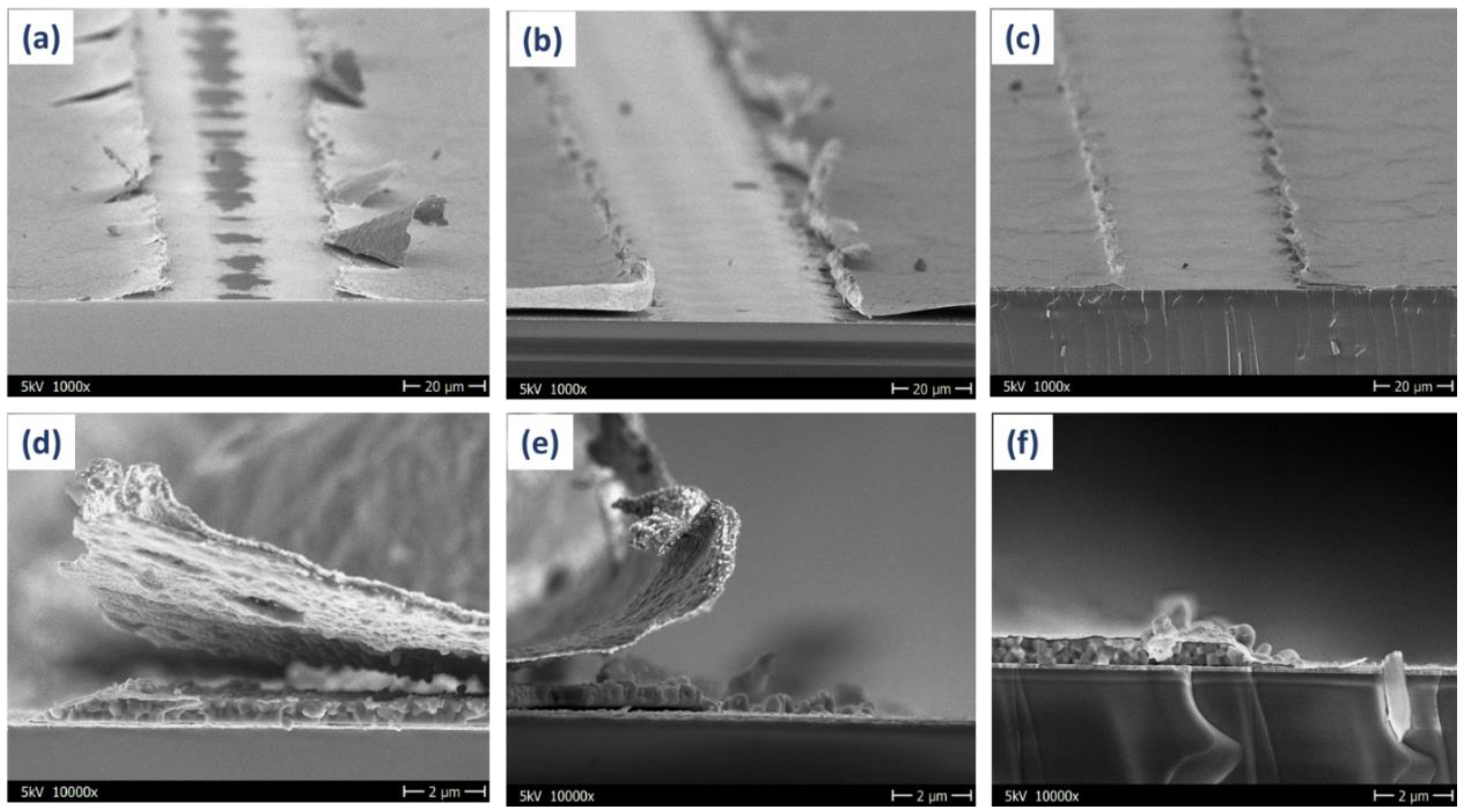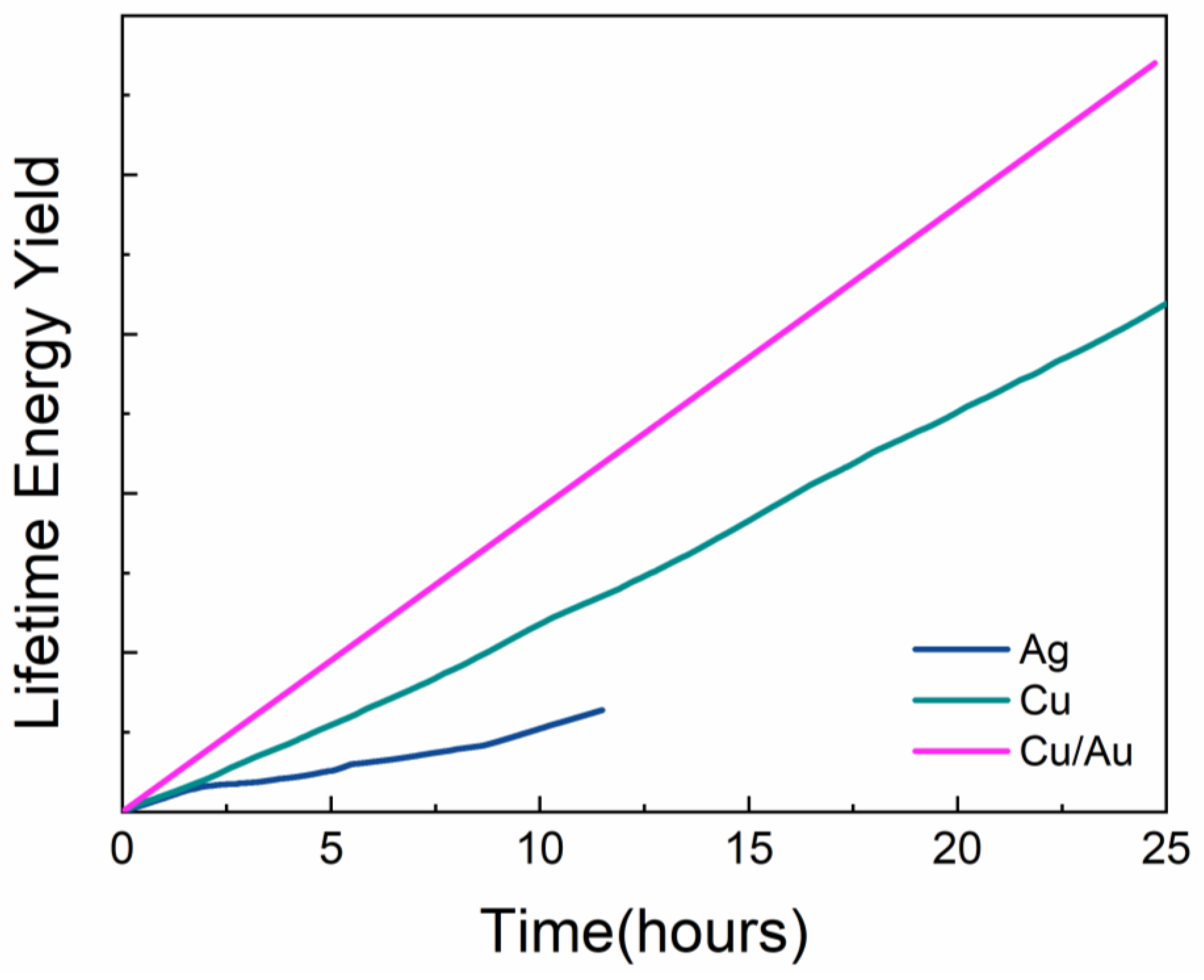Stability Assessment of p-i-n Perovskite Photovoltaic Mini-Modules Utilizing Different Top Metal Electrodes
Abstract
:1. Introduction
2. Results and Discussion
3. Conclusions
4. Experimental Section
4.1. Materials
4.2. Perovskite Precursor Inks Preparation
4.3. Perovskite Mini-Module Fabrication
4.4. Sample Characterization
Solar Mini-Module Characterization
4.5. SEM Measurements
Supplementary Materials
Author Contributions
Funding
Acknowledgments
Conflicts of Interest
References
- Best Research-Cell Efficiency Chart. 2021. Available online: https://www.nrel.gov/pv/cell-efficiency.html (accessed on 11 April 2021).
- Dagar, J.; Fenske, M.; Al-Ashouri, A.; Schultz, C.; Li, B.; Köbler, H.; Munir, R.; Parmasivam, G.; Li, J.; Levine, I.; et al. Compositional and Interfacial Engineering Yield High-Performance and Stable p-i-n Perovskite Solar Cells and Mini-Modules. ACS Appl. Mater. Interfaces 2021, 13, 13022–13033. [Google Scholar] [CrossRef]
- Bi, D.; Yi, C.; Luo, J.; Décoppet, J.-D.; Zhang, F.; Zakeeruddin, S.M.; Li, X.; Hagfeldt, A.; Grätzel, M. Polymer-templated nucleation and crystal growth of perovskite films for solar cells with efficiency greater than 21%. Nat. Energy 2016, 1, 16142. [Google Scholar] [CrossRef]
- Saliba, M.; Matsui, T.; Domanski, K.; Seo, J.-Y.; Ummadisingu, A.; Zakeeruddin, S.M.; Correa-Baena, J.-P.; Tress, W.R.; Abate, A.; Hagfeldt, A.; et al. Incorporation of rubidium cations into perovskite solar cells improves photovoltaic performance. Science 2016, 354, 206–209. [Google Scholar] [CrossRef] [PubMed]
- Stolterfoht, M.; Wolff, C.M.; Márquez, J.A.; Zhang, S.; Hages, C.J.; Rothhardt, D.; Albrecht, S.; Burn, P.L.; Meredith, P.; Unold, T.; et al. Visualization and suppression of interfacial recombination for high-efficiency large-area pin perovskite solar cells. Nat. Energy 2018, 3, 847–854. [Google Scholar] [CrossRef]
- Wang, Z.; Lin, Q.; Chmiel, F.P.; Sakai, N.; Herz, L.M.; Snaith, H.J. Efficient ambient-air-stable solar cells with 2D–3D heterostructured butylammonium-caesium-formamidinium lead halide perovskites. Nat. Energy 2017, 2, 17135. [Google Scholar] [CrossRef]
- Dagar, J.; Castro-Hermosa, S.; Lucarelli, G.; Cacialli, F.; Brown, T.M. Highly efficient perovskite solar cells for light harvesting under indoor illumination via solution processed SnO2/MgO composite electron transport layers. Nano Energy 2018, 49, 290–299. [Google Scholar] [CrossRef] [Green Version]
- Dagar, J.; Hirselandt, K.; Merdasa, A.; Czudek, A.; Munir, R.; Zu, F.; Koch, N.; Dittrich, T.; Unger, E.L. Alkali Salts as Interface Modifiers in n-i-p Hybrid Perovskite Solar Cells. Sol. RRL 2019, 3, 1900088. [Google Scholar] [CrossRef]
- Schultz, C.; Fenske, M.; Dagar, J.; Zeiser, A.; Bartelt, A.; Schlatmann, R.; Unger, E.; Stegemann, B. Ablation mechanisms of nanosecond and picosecond laser scribing for metal halide perovskite module interconnection—An experimental and numerical analysis. Sol. Energy 2020, 198, 410–418. [Google Scholar] [CrossRef]
- Li, J.; Dagar, J.; Shargaieva, O.; Flatken, M.A.; Köbler, H.; Fenske, M.; Schultz, C.; Stegemann, B.; Just, J.; Többens, D.M.; et al. 20.8% Slot-Die Coated MAPbI3 Perovskite Solar Cells by Optimal DMSO-Content and Age of 2-ME Based Precursor Inks. Adv. Energy Mater. 2021, 11, 2003460. [Google Scholar] [CrossRef]
- Dagar, J.; Castro-Hermosa, S.; Gasbarri, M.; Palma, A.L.; Cina, L.; Matteocci, F.; Calabrò, E.; Di Carlo, A.; Brown, T.M. Efficient fully laser-patterned flexible perovskite modules and solar cells based on low-temperature solution-processed SnO2/mesoporous-TiO2 electron transport layers. Nano Res. 2018, 11, 2669–2681. [Google Scholar] [CrossRef]
- Palma, A.L.; Matteocci, F.; Agresti, A.; Pescetelli, S.; Calabro, E.; Vesce, L.; Christiansen, S.; Schmidt, M.; Di Carlo, A. Laser-Patterning Engineering for Perovskite Solar Modules with 95% Aperture Ratio. IEEE J. Photovolta. 2017, 7, 1674–1680. [Google Scholar] [CrossRef]
- Calabrò, E.; Matteocci, F.; Palma, A.L.; Vesce, L.; Taheri, B.; Carlini, L.; Pis, I.; Nappini, S.; Dagar, J.; Battocchio, C.; et al. Low temperature, solution-processed perovskite solar cells and modules with an aperture area efficiency of 11%. Sol. Energy Mater. Sol. Cells 2018, 185, 136–144. [Google Scholar] [CrossRef]
- Mincuzzi, G.; Palma, A.L.; Di Carlo, A.; Brown, T.M. Laser Processing in the Manufacture of Dye-Sensitized and Perovskite Solar Cell Technologies. ChemElectroChem 2015, 3, 9–30. [Google Scholar] [CrossRef]
- Matteocci, F.; Vesce, L.; Kosasih, F.U.; Castriotta, L.A.; Cacovich, S.; Palma, A.L.; Divitini, G.; Ducati, C.; Di Carlo, A. Fabrication and Morphological Characterization of High-Efficiency Blade-Coated Perovskite Solar Modules. ACS Appl. Mater. Interfaces 2019, 11, 25195–25204. [Google Scholar] [CrossRef] [PubMed]
- Fenske, M.; Schultz, C.; Dagar, J.; Kosasih, F.U.; Zeiser, A.; Junghans, C.; Bartelt, A.; Ducati, C.; Schlatmann, R.; Unger, E.; et al. Improved Electrical Performance of Perovskite Photovoltaic Mini-Modules through Controlled PbI 2 Formation Using Nanosecond Laser Pulses for P3 Patterning. Energy Technol. 2021, 9, 2000969. [Google Scholar] [CrossRef]
- Heo, J.H.; Han, H.J.; Kim, D.; Ahn, T.K.; Im, S.H. Hysteresis-less inverted CH3NH3PbI3 planar perovskite hybrid solar cells with 18.1% power conversion efficiency. Energy Environ. Sci. 2015, 8, 1602–1608. [Google Scholar] [CrossRef]
- Al-Ashouri, A.; Köhnen, E.; Li, B.; Magomedov, A.; Hempel, H.; Caprioglio, P.; Márquez, J.A.; Vilches, A.B.M.; Kasparavicius, E.; Smith, J.A.; et al. Monolithic perovskite/silicon tandem solar cell with >29% efficiency by enhanced hole extraction. Science 2020, 370, 1300–1309. [Google Scholar] [CrossRef]
- Al-Ashouri, A.; Magomedov, A.; Roß, M.; Jošt, M.; Talaikis, M.; Chistiakova, G.; Bertram, T.; Márquez, J.A.; Köhnen, E.; Kasparavičius, E.; et al. Conformal monolayer contacts with lossless interfaces for perovskite single junction and monolithic tandem solar cells. Energy Environ. Sci. 2019, 12, 3356–3369. [Google Scholar] [CrossRef] [Green Version]
- Moon, S.-J.; Yum, J.-H.; Lofgren, L.; Walter, A.; Sansonnens, L.; Benkhaira, M.; Nicolay, S.; Bailat, J.; Ballif, C. Laser-Scribing Patterning for the Production of Organometallic Halide Perovskite Solar Modules. IEEE J. Photovolta. 2015, 5, 1087–1092. [Google Scholar] [CrossRef]
- Rakocevic, L.; Mundt, L.E.; Gehlhaar, R.; Merckx, T.; Aernouts, T.; Schubert, M.C.; Glunz, S.W.; Poortmans, J. Loss Analysis in Perovskite Photovoltaic Modules. Sol. RRL 2019, 3, 1900338. [Google Scholar] [CrossRef]
- Volkov, A. Structure and mechanical properties of CuAu and CuAuPd ordered alloys. Gold Bull. 2004, 37, 208–215. [Google Scholar] [CrossRef] [Green Version]
- Xie, Y.-Q.; Li, Y.-F.; Liu, X.-B.; Li, X.-B.; Peng, H.-J.; Nie, Y.-Z. Characteristic atom occupation patterns of Au3Cu, AuCu3, AuCuI and AuCuII based on experimental data of disordered alloys. Trans. Nonferr. Met. Soc. China 2011, 21, 1092–1104. [Google Scholar] [CrossRef]
- Jiang, Z.; Chen, X.; Lin, X.; Jia, X.; Wang, J.; Pan, L.; Huang, S.; Zhu, F.; Sun, Z. Amazing stable open-circuit voltage in perovskite solar cells using AgAl alloy electrode. Sol. Energy Mater. Sol. Cells 2016, 146, 35–43. [Google Scholar] [CrossRef]
- Lai, W.-C.; Lin, K.-W.; Guo, T.-F.; Chen, P.; Liao, Y.-Y. Efficient CH3NH3PbI3 perovskite/fullerene planar heterojunction hybrid solar cells with oxidized Ni/Au/Cu transparent electrode. Appl. Phys. Lett. 2018, 112, 71103. [Google Scholar] [CrossRef]
- An, Z.; Li, J.; Kikuchi, A.; Wang, Z.; Jiang, Y.; Ono, T. Mechanically strengthened graphene-Cu composite with reduced thermal expansion towards interconnect applications. Microsyst. Nanoeng. 2019, 5, 20. [Google Scholar] [CrossRef] [PubMed]
- Barngrover, B.M.; Aikens, C.M. Incremental Binding Energies of Gold(I) and Silver(I) Thiolate Clusters. J. Phys. Chem. A 2011, 115, 11818–11823. [Google Scholar] [CrossRef] [PubMed] [Green Version]
- Unger, E.; Paramasivam, G.; Abate, A. Perovskite solar cell performance assessment. J. Phys. Energy 2020, 2, 044002. [Google Scholar] [CrossRef]
- Khenkin, M.V.; Anoop, K.M.; Visoly-Fisher, I.; Galagan, Y.; Di Giacomo, F.; Patil, B.R.; Sherafatipour, G.; Turkovic, V.; Rubahn, H.-G.; Madsen, M.; et al. Reconsidering figures of merit for performance and stability of perovskite photovoltaics. Energy Environ. Sci. 2018, 11, 739–743. [Google Scholar] [CrossRef] [Green Version]
- Terrestrial Photovoltaic (PV) Modules—Design Qualification and Type Approval—Part 1: Test Requirements. Available online: https://infostore.saiglobal.com/preview/258973459811.pdf?sku=880220_SAIG_NSAI_NSAI_2091247 (accessed on 19 December 2016).
- Qian, J.; Ernst, M.; Wu, N.; Blakers, A. Impact of perovskite solar cell degradation on the lifetime energy yield and economic viability of perovskite/silicon tandem modules. Sustain. Energy Fuels 2019, 3, 1439–1447. [Google Scholar] [CrossRef]



| PV Parameters | Ag | Cu | Cu/Au |
|---|---|---|---|
| ISC (mA) | 16.27 | 15.93 | 15.83 |
| VOC (V) | 3.36 | 3.39 | 3.40 |
| FF (%) | 68.3 | 71.7 | 74.1 |
| PCE (%) | 17.0 | 17.6 | 18.3 |
| PCEMPP (%) | 16.9 | 17.3 | 18.9 |
Publisher’s Note: MDPI stays neutral with regard to jurisdictional claims in published maps and institutional affiliations. |
© 2021 by the authors. Licensee MDPI, Basel, Switzerland. This article is an open access article distributed under the terms and conditions of the Creative Commons Attribution (CC BY) license (https://creativecommons.org/licenses/by/4.0/).
Share and Cite
Dagar, J.; Paramasivam, G.; Klimm, C.; Fenske, M.; Schultz, C.; Schlatmann, R.; Stegemann, B.; Unger, E. Stability Assessment of p-i-n Perovskite Photovoltaic Mini-Modules Utilizing Different Top Metal Electrodes. Micromachines 2021, 12, 423. https://doi.org/10.3390/mi12040423
Dagar J, Paramasivam G, Klimm C, Fenske M, Schultz C, Schlatmann R, Stegemann B, Unger E. Stability Assessment of p-i-n Perovskite Photovoltaic Mini-Modules Utilizing Different Top Metal Electrodes. Micromachines. 2021; 12(4):423. https://doi.org/10.3390/mi12040423
Chicago/Turabian StyleDagar, Janardan, Gopinath Paramasivam, Carola Klimm, Markus Fenske, Christof Schultz, Rutger Schlatmann, Bert Stegemann, and Eva Unger. 2021. "Stability Assessment of p-i-n Perovskite Photovoltaic Mini-Modules Utilizing Different Top Metal Electrodes" Micromachines 12, no. 4: 423. https://doi.org/10.3390/mi12040423
APA StyleDagar, J., Paramasivam, G., Klimm, C., Fenske, M., Schultz, C., Schlatmann, R., Stegemann, B., & Unger, E. (2021). Stability Assessment of p-i-n Perovskite Photovoltaic Mini-Modules Utilizing Different Top Metal Electrodes. Micromachines, 12(4), 423. https://doi.org/10.3390/mi12040423







